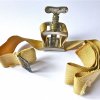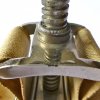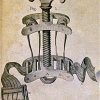Surgery |
||
Compression bandage |
||
|
The compression of a severely bleeding vein took place chemically in the first attempt: a) by etching blood vessels with copper vitriol; b) Compresses were soaked in brandy c) a fungus was commonly used: the (burst) bovist, which, dried, was used as a hemostatic dressing, which is why it was called "fungus chirurgorum" (fungus of surgeons).
Only when chemicals were not available and neither finger pressure nor Umstechen *, nor burning helped, only then applied the surgeon a pressure bandage. The German Wilhelm Fabry von Hilden (1560-1624) and Hans von Gersdorf are said to have used a primitive form of Garrot, a wooden peg that was slid under a ligature from a hairnet and turned off.
* The invention of the mass ligature is attributed to the Besançon surgeon Etienne Jean MOREL (1648-1710), who was said to have used a toggle tourniquet in 1674 at the Battle of Besançon (Seerig AWH, Armamentarium chirurgicum or as complete a collection of illustrations and descriptions of surgical Instruments of older and more recent times Volume I-II and ribbon with 145 lithographed plates Breslau: A Gosohorsky 1838) - un simple lien circulaire, garrotté autour du membre au moyen d'un bâton. Morel appela cet instrument par conséquent un "garrot". (See "la garrotte", the choking iron).
In 1674 au siège de Besançon, un chirurgien nommé Morel imagina de comprimer les vaisseaux sanguins par un appareil de sa fabrication: un garrot circulaire comportant une cheville dont on réglait la tension en la tournant sur elle-même, d'où le nom de tourniquet Régulièrement perfectionné, cet appareil fut utilisé jusqu'au 19e siècle, Bien que l'hémostase dans les amputations des membres ait encore été améliorée par l'utilization tourniquets à vis, la mortalité suite aux infections resta élevée "(Musée).
Morel had used his device for emergency hemostasis, the French surgeon Jean Louis PETIT (1674-1750) devised a device for use in planned amputations. His device no longer compressed the entire limb, but only the heavily bleeding main trunk of the artery. In 1718 he published the picture of his screw-type journal, which he called "tourniquet à vis", which gradually compressed the extremity to be amputated - the idea of the instrument. First versions made of wood, later made of metal. (tornaculum, torquilar).
Heister has improved the device in 1740. Nevertheless, ES had a very unpleasant feature: the tendency to topple over. "plus la pression est forte, plus la plaque supérieure s'élève, l'appareil devient trop pour pour base, le moindre choc le renverse, ou pendant l'opération par les mouvement du malade et la contraction des muscles, ou après, par quelque choc imprévu, ce qui occasionne souvent une hémorrhagie promptement mortelle "(HV Malan, Recherches sur un nouveau tourniquet, in: L'Esculape, gazette des médecins praticiens n ° 1 du 7 février 1841, p. 82)
The putting on of the tourniquet was painful. Often valuable time was lost. Many surgeons considered tourniquets to be superfluous, indeed dangerous (Robert Liston, Commentaries on Tourniquets, in: Edinbourgh Medical Surgical Journal, Jan. 1854, cited in: Notes from the Field of Natural and Medical Science, 1824, p ). It was only in the 18th century that Petit's Arteriabbinder came into use to a greater extent. Bleeding from the limb was often too intense, although blood could not flow back to the heart, but the influx of arterial blood was not really prevented by insufficient compression.
Exhibit The handle of our tourniquet is identical to the copy reproduced by Anton Bum (1856-1925) "Therapeutic Encyclopedia, Practical Doctors, Urban & Schwarzenberg, Vienna, 1891" p. Dating therefore around 1890). |






